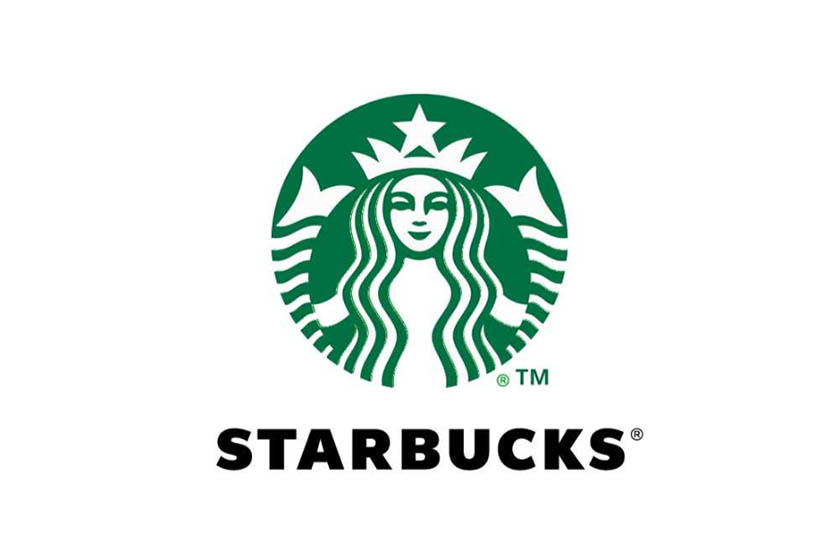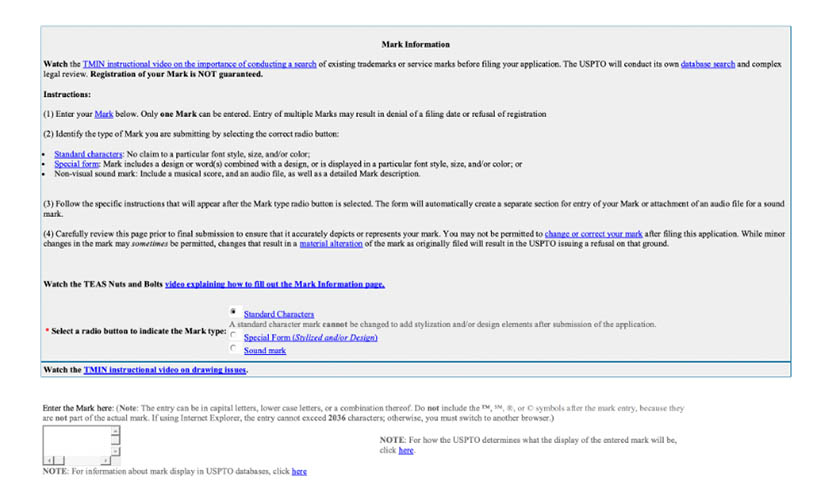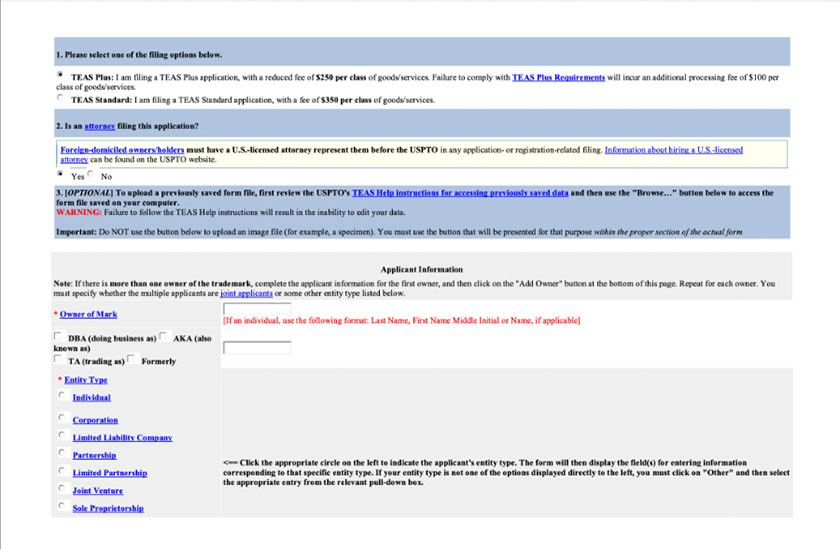Trademarking your business name is an essential part of building your business. Trademarking gives you a rock-solid, legal claim to your business name and all its other public-facing elements, such as its logo and tagline. Also, establishing a trademark sets up your business for the long term, especially if you plan on expanding in the future. Keep reading to learn what trademarks are, why they’re important, and the four steps for how to trademark a business name.
What a Business Name Trademark Is & Why It’s Important
Because a trademark gives your business a legal claim to its name and public identity, it’s a significant part of building your brand presence. A trademark protects your business’ public assets (e.g., its name, logo, and other branding symbols) and ensures that they always belong solely to your business. In short, a trademark prevents other people or businesses from potentially stealing your brand assets and claiming them as their own.
For instance, you wouldn’t be able to use the Starbucks siren symbol because it’s trademarked to the Starbucks brand—it’s a piece of their intellectual property (IP). In the same way, you wouldn’t be able to use Marvel Studios’ “Marvel” wordmark because it belongs to Disney. Some companies have even trademarked specific colors—for instance, Tiffany Blue or Barbie Pink. If other businesses use these assets, these companies have legal grounds to sue them.
You’ll also know when a name or logo is trademarked usually by seeing a small “TM” or Ⓡ symbol alongside it. This lets other people and businesses know that that asset is legally trademarked.
So if you’re serious about building your small business for the long term, or if you have plans of expanding your business nationwide, learning how to trademark a name and logo (and other brand assets) is one of the best things you can do to protect and prolong your business’ brand identity.
A business name trademark is a form of legal protection over your business’ name and other public branding assets like your logo, slogan, or color scheme. A trademark gives your business sole ownership over these assets and prevents other businesses or individuals from using them for their own profit.
The Difference Between a Trademark & Copyright
While trademarks and copyrights live in the same neighborhood of IP rights, they have a few key differences. A copyright is simply a legal protection over a piece of original work you’ve created, such as a photograph, a piece of writing, or a song, and is therefore more used by artists and creatives. Meanwhile, trademarks are protection specifically for business assets—logos, slogans, brand names—or any symbol directly related to your business.
Trademarking your brand gives you protection and assurance that your business alone can use its brand name, logo, or other assets for marketing and profit. At the same time, checking trademarks against trademark databases also prevents you from using other business’ trademarked assets. Trademarks legally distinguish businesses from one another and help identify you to the public.
Know the Difference…
Copyrights: Protect a piece of original work you’ve created, such as a song, film, or artwork
Patents: Protect an original invention or process, e.g., a new medical device
Trademarks: Protect your business’ brand assets, such as your brand name and logo, and prevent other businesses from using them
What a Trademark Does (& Doesn’t Do)
The main function of a trademark is to give your business legal ownership over its brand assets: its name, logo, and even its brand colors. But that isn’t its sole purpose. While trademarks are your best protection against infringement, they’re also an effective marketing tool since they help make your business more recognizable to the public.
Here are some of the most important functions a trademark does:
- It protects your business against infringement: Having legal claim over your business’ brand assets is also your best protection against other businesses that may try to steal or replicate your goods, services, or brand identity elements.
- It identifies you to the public: Having a solid brand identity also makes your business more identifiable and recognizable to the public. Take, for instance, the Starbucks siren—because it belongs solely to Starbucks, it’s become synonymous with the brand and distinguishes it from other coffee brands.
- It allows you to expand: Because a registered trademark lasts forever (as long as you renew it), having a trademark allows you to expand your business to other locations nationwide, or even open it up for franchising.
- It also protects your product or service: Trademarks also protect your business’ products or services, including the names of products, such as Coke or Band-Aid (more on Band-Aid later). Trademarking your business also protects the ideas behind your actual offerings from being stolen.
However, while a trademark protects your business’ products, services, and brand assets commercially, it doesn’t completely gatekeep it from all public use. For instance, having a trademark doesn’t shield your business from being published in the media—whether for good or bad coverage.
Here are some other things a trademark doesn’t do:
- It doesn’t prevent the media from publishing it: The media have a right to cover any business, including yours, for coverage good or bad. A trademark doesn’t protect your business from being published in any media platform or being mentioned in any news story.
- It doesn’t protect a non-business-related word or artwork: Trademarks are always connected to a business, so their scope of protection does not include anything outside your business. So say if you’ve sketched an original drawing, it isn’t available for trademark—you’ll need a copyright for that instead.
- It doesn’t protect your trademark overseas: Trademarks are filed under U.S. law, which means they don’t apply to other countries. If you wish to expand your business internationally, you’ll need to file trademarks in each country separately.
Keep tabs on your trademark
Once you have a trademark established, it’s important you guard that trademark through constant monitoring of the market and legal action when necessary. Failure to do so can result in losing your trademark because your brand or product name becomes generic. Band-Aid bandages are a good example of this.

Band-Aid bandages still carry the Circle-R trademark symbol, but that mark is unenforceable.
Johnson & Johnson, the maker of Band-Aid brand bandages, first trademarked their product in the 1920s. However, over time, “bandaid” became a generic term for any self-adhesive bandage. By the time Johnson & Johnson took action, it was too late. Courts ruled the Band-Aid trademark was unenforceable because it had become too commonly used.
How to Trademark a Business Name in 4 Steps
While trademarking your business name is essential for setting it up for its long-term success, it isn’t an automatic process. Finalizing your business name or logo doesn’t automatically make them government-recognized trademarks. You’ll need to apply for your trademarks manually with the U.S. Patent and Trademark Office (USPTO) for them to be official trademarks.
Owning vs registering a trademark: While there is a common law allowing you to own a trademark as soon as you start using it, it doesn’t have solid legal grounding the same way a registered trademark does, so its protections are limited. While owning a common law trademark might be enough for a local community business, you’ll need a registered trademark if you plan on expanding your business nationally.
Follow the steps below to learn how to trademark a business name in four steps.
1. Finalize the Parts of Your Trademark
If you’re reading this article, you probably already have an idea of what you want to trademark from your business, whether it’s your business name or logo, a product name, or even a mascot. However, before you start preparing your documents to submit to the USPTO, you’ll need to gather and finalize the parts of your trademark based on the office’s standards.
The USPTO has specific standards for trademarks because there are thousands of trademarked businesses in the U.S., and each one is different. You need to make sure yours is completely unique from them all.
So, the first step for how to trademark a business name is to identify three specific parts of the trademark you want to apply for: your trademark format, the products or services your trademark will apply to, and the basis for your application. Find more about each below.
Your trademark format is the basic visual appearance of your trademark, which the USPTO also calls a “trademark drawing.” There are two types: a standard character drawing and a special form drawing.
- A standard character drawing is your business’ basic name, without any special styling or formatting. So for example, Fit Small Business’ standard character drawing is simply, “FIT SMALL BUSINESS,” without any specific font, styling, logo, color—just the name alone.
- Meanwhile, a special form drawing is the stylized form of your business name, or it can even be your business’ logo. For Fit Small Business, this would mean the stylized form of its name with the specific font and formatting.
If you’re only looking to trademark a business name alone, you can do so via a standard character drawing. However, if you want to trademark its specific visual styling, or, for example, if your logo is a stylized wordmark of your business name, you’ll opt for a special form drawing instead. You can also file trademarks for both, but you’ll need to file them separately.
Keep in mind that if your business name includes foreign characters, you might be required to provide an explanation of its meaning. Find out more about the USPTO’s drawing requirements here.
The second part of finalizing the parts of your trademark is to clearly identify the products or services that your trademark will apply to. It’s simple: you can check all the different trademark categories on the USPTO’s trademark ID manual master list. Type in the keyword for your general category, then note the specific class and type it falls under from the master list.
For instance, here are all the different trademark categories under the search term “coffee.” If you were opening a coffee shop, your trademark would fall under “Services,” class 43: “coffee shops.”
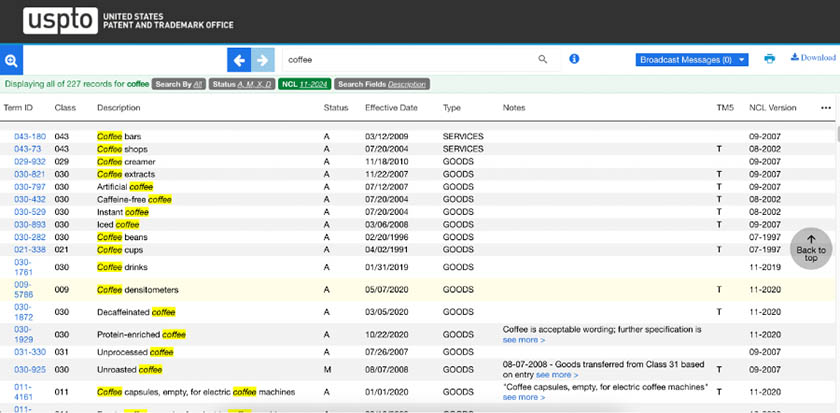
An example of the categories under the search term “coffee” (Source: USPTO.gov)
Finally, you’ll also need to provide the basis of your trademark application, aka your “filing basis.” This is the main purpose behind why you want to trademark your business, whether it’s simply to officialize your name and logo or to expand your business globally. There are four types of trademark bases, and you need to have at least one in your application:
- Use in commerce basis: Use this basis if you are already currently using a trademark for your business (e.g., on a business name or logo) and simply want to register it officially with the government.
- Intent-to-use basis: Use this if you already have a trademark but aren’t using it yet, but are planning to in the near future—essentially, if you want to register your trademark first before using it for your business.
- Foreign registration basis: This trademark only applies if you started and trademarked your business in a different country, and want to trademark it in the U.S. as well.
- Foreign application basis: This only applies if you made a foreign trademark registration no more than six months before your current U.S. trademark application, and you want both to have the same registration date.
Before moving forward with your application, it’s important to check that the trademark you’re filing is unique. It can’t resemble any other pre-existing trademarks. To minimize the chances of your trademark being rejected, do a quick double-check to ensure the name, logo, or slogan you’re trademarking doesn’t already belong to another business. You can do this by checking the USPTO’s trademark database.
2. File & Pay for Your Trademark Application
Once you’ve rounded up and finalized all the details of your trademark, you’re ready to file your application with the government. The filing application is all done online via the USPTO website.
First, you’ll need to create an account with the USPTO and then verify your identity. Verifying your identity is mandatory for anyone filing a trademark. You can verify your identity online via a selfie, by video-calling with an agent, or offline by submitting a paper application form—however, the latter can take up to three weeks.
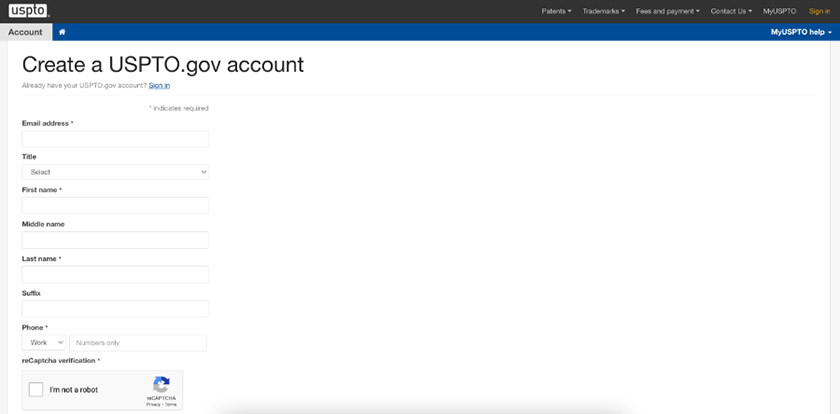
Create an account with the USPTO on the website first before you can submit a trademark application.
Once your account is set up and verified, log in to your USPTO account and fill in the online Trademark Electronic Application System (TEAS) form. In this form, you’ll need to enter information such as the type of business you own (individual, corporation, and so on), its location, website, and other details of your wordmark—including an upload of its image file.
In the form, you’ll also need to pay your trademark application fee online via bank transfer, automated deposit, or credit card. It’s important to understand you are paying a processing fee. In the event your application is ultimately rejected, the fee still stands. You won’t get a refund. After submitting the application form, you’ll be issued a serial number for your application.
The fees for how much to trademark a business name can differ based on your type of application. TEAS Plus applications cost $250 and are only suitable for applications with products or services listed in the Trademark ID Manual. However, if your products or services aren’t listed in the manual and need custom categories, you’ll need a TEAS Standard application, which costs $350.
3. Monitor Your Trademark Application
After you’ve submitted your application and paid the application fee, the next step in the process of trademarking business names is to wait—sometimes up to a few months. During the waiting period, USPTO officials will review your application to see if your trademarks are valid.
At this stage, you can also monitor the status of your application online on the Trademark Status & Document Retrieval Platform (TSDR). On the platform, type in your serial number, and it’ll show you the status of your application.
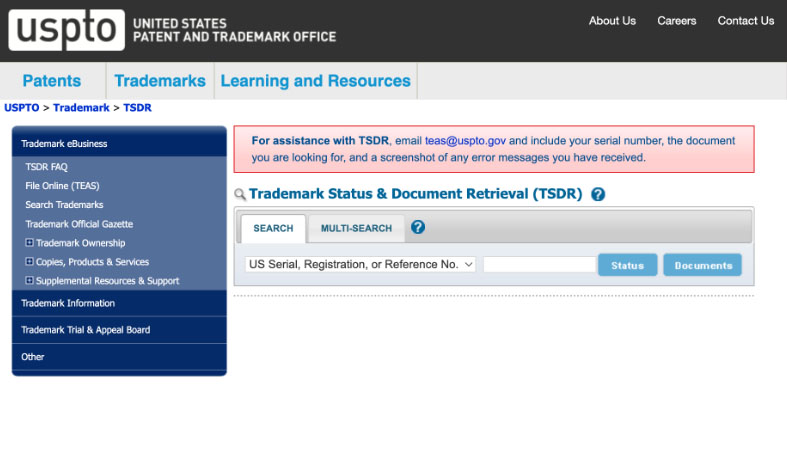
Monitor your application status via the TSDR platform. (Source: USPTO.gov)
Comply With Additional USPTO Office Actions
As you wait for your application, you may receive a letter from the USPTO calling for “office actions.” This means that USPTO attorneys found legal problems with your application, ranging from minor technical issues with your uploaded file to more significant concerns, such as finding an already existing trademark that closely resembles yours and might potentially lead to confusion.
You will have three months to resolve the issues outlined in the office action and respond to the USPTO. For minor issues, emailing or calling your examining attorney is sometimes enough to resolve the issue, while more major actions may need a written response. However, some actions can’t be resolved at all, during which you’ll receive a refusal office action outlining their reasons for rejecting your application.
Why do trademark applications get rejected? There are any number of reasons why the USPTO may reject your application. However, the most common cause is the potential of your trademark causing confusion—meaning it’s too similar to someone else’s. Another reason your application may be rejected is if the reviewer feels your trademark is misleading (for example, if your cafe’s name is “New York Coffee” but is based in Tennessee). Find out more about the possible reasons for a trademark rejection.
4. Receive Approval for Your Trademark Application
If you’ve resolved all the issues in your office action (or if you didn’t receive one at all), the next step is to wait for the USPTO’s approval of your application. You’ll know if your application is approved once it appears in the USPTO’s official gazette, which is published on its website every Tuesday.
However, this is not the very end of the process of trademarking business names. Once your trademark is published in the USPTO’s gazette, there will be a 30-day period in which other business owners can file oppositions to your trademark. However, if your trademark receives no opposition, there are two ways to end the application process, depending on the basis of your application:
- If the basis of your trademark is for use in commerce: The USPTO will send you a certificate of registration, which officially registers your trademark as belonging to your business. You’re free to use your trademark as you need.
- If the basis of your trademark is intent-to-use: The USPTO will send you a notice of allowance, after which you’ll need to submit a Statement of Use (SOU) of your trademark within six months. The SOU form is accessible after logging in to the USPTO’s website, and you’ll need to submit it along with additional requirements and a fee. If your SOU is approved, your trademark is yours to use.
Following the steps above will get you through the process of how to protect a business name with a trademark. However, after you’ve received your trademark, you’ll also need to maintain it regularly by filing for registration maintenance after the five-year and nine-year marks, then every 10 years thereafter.
You’ll also need to prove that you’re regularly using your trademark and delete any products or services that are no longer part of your business if there are any. The same process also applies to how to trademark a logo. You’ll need to maintain your registration regularly.
How to Check if a Business Name Is Trademarked
Checking trademarked business names is an important step in the process of how to trademark a name for a business. Thankfully, it’s also an easy process—you’ll only need to check the USPTO’s online Trademark Search database (formerly known as the Trademark Electronic Search System or TESS), which lists all the existing business trademarks in the United States.
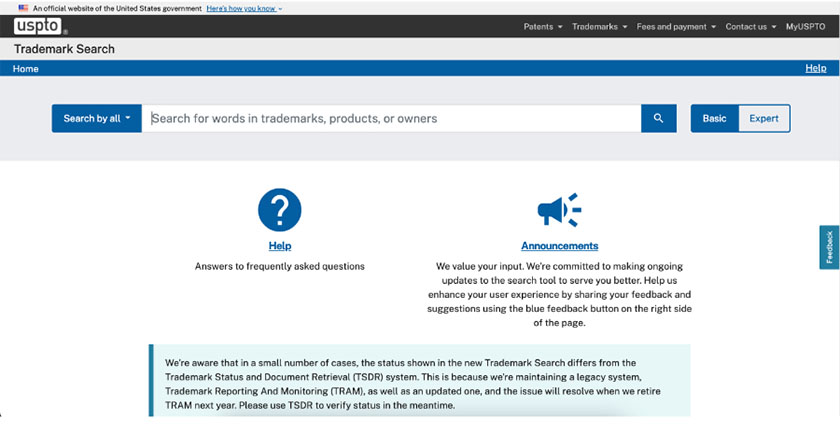
Search for existing trademarks using the USPTO’s Trademark Search database. (Source: USPTO.gov)
On the database’s search bar, type in the name or products you’re applying trademarks for, or you can even search for the names of other business owners. After clicking the search icon, the platform will generate a list of trademarks that match your search terms. For instance, here are the trademarks that show up under the search term “fit small business”:
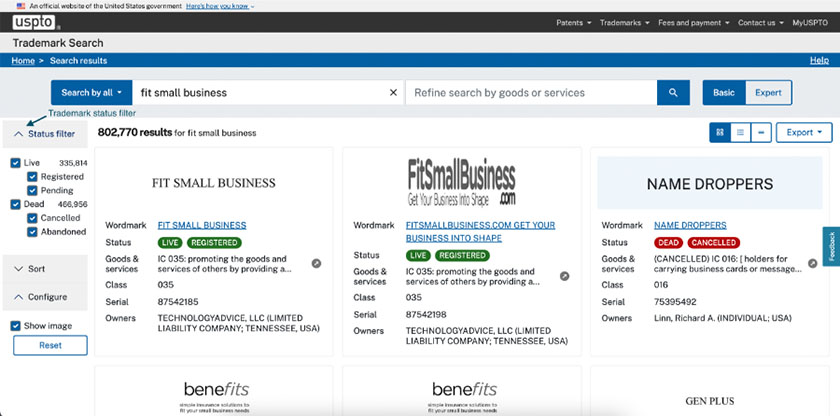
An example of registered trademarks matching the search term “fit small business” (Source: USPTO.gov)
You’ll also see their trademark statuses (“registered” or “canceled”), which you can filter on the left-hand panel. You can also view the trademark class they’re filed under, the products or services each business offers, and the owners of the trademark.
This database is completely open and free for the public to access, so be sure to use it anytime you plan on filing a trademark to check if there are any similar ones already in use. Doing so will minimize the chances of your trademark application being rejected.
Frequently Asked Questions (FAQs)
The cost to trademark a business name is $250 for a TEAS Plus application or $350 for a TEAS Standard application. TEAS Plus applications only apply to businesses with goods or services that fall under the USPTO’s trademark ID manual. However, if your business’ products or services need custom descriptions, you’ll need to apply for a TEAS Standard application. All trademark application fees are paid for during the application process.
Trademarking your business name officializes it as belonging solely to your business. It also protects your business name (and other brand assets) from being stolen by other businesses and used for other products or services than your own. Besides legal protection, a trademark also establishes your business as being unique from others, making it more recognizable to audiences. In essence, a trademark sets up your brand identity for the long term.
Trademarking a business name doesn’t have to be difficult, as long as you follow the proper procedure: gathering all the parts of your trademark, submitting the online application form and paying the fee, then monitoring your trademark application and complying with any additional USPTO requirements. You can also easily check for any existing trademarks online via the website. However, if you need more assistance, you can always hire a lawyer.
Registering a trademark doesn’t require you to hire a lawyer. You can successfully complete the registration process on your own. However, many small businesses choose to hire a lawyer anyway, as the process can be fraught with challenges and questions business owners may not be equipped to answer. If you choose to hire a lawyer to file your trademark, expect to pay somewhere between $1,000 and $3,000.
Bottom Line
Trademarking your business name and brand assets may seem intimidating, but it all comes down to having the right information about your trademark and submitting all the right forms. Not only can knowing how to trademark a business name grant your business lifelong protection, but it can also be a powerful branding tool by establishing your business’ unique identity in the market. And, it’s possible for anyone—just follow the steps above to get started.
